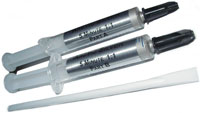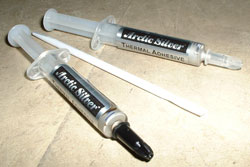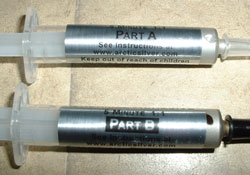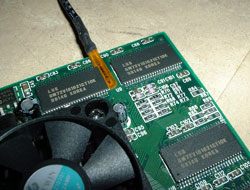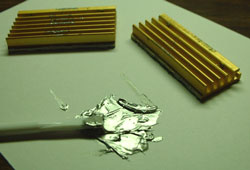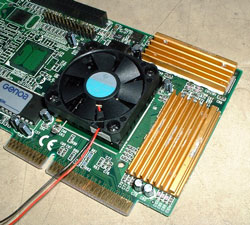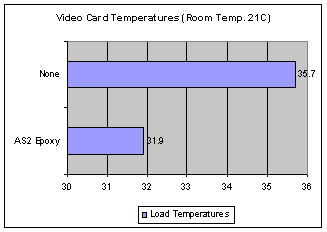|
|
|
Arctic Silver II Epoxy Review Date: October 23, 2001 |
| Provider: Below Zero |
| Manufacturer: Arctic Silver |
| Author: Mikhail Ivanenkov |
|
Before I begin I'd like to thank Luke from Below Zero for sending over this compound along with some other things. Almost everyone has heard of Arctic Silver II, but not a whole lot know the story behind the two-step epoxy. Arctic Silver was first introduced a while back when Duron and Tbird mania hit the streets. The extremely high heat output of AMD chips caused manufacturers to produce more and better heatsinks. At the same time, the need for a better thermal interface material (TIM) arose. Up until that point people used either thermal tape (aka "frag tape") or silicon compound. There were and still are lots of companies that make both, as most people are oblivious to their value or in this case, lack thereof. The problem with a silicon-based pad/paste is that at high temperatures it tends to dry up, forming air pockets and losing it's conductive properties. The whole point of a TIM is to fill up the possible gaps between processor core and heatsink. After time this contact wears down and the heat factor rises. There are a select few thermal pads that undergo a phase change where they heat-fuse to the heatsink/cpu thus increasing efficiency, but this requires a high increases in temperatures for a short period of time, something that's not good for your processor. Arctic Silver was pretty much alone with they released their first compound made of silver particles. Silver is a much better conductor of heat that aluminum or copper but is also costly. Therefore the first product was a bit expensive. After some time they released AS2, 78% silver. It not only cost less but also performed better. So where does the epoxy come in? Glad you asked. While it's not meant for your processor's heatsink because it's permanent, AS2 epoxy is designed for use with heatsinks that don't attach in any natural way. Actually it's more of an overclocker's plaything, since most areas that require active/passive cooling will already have something there. A perfect example is the video card. The newest models have very high clocked memory chips which tend to heat up quite a bit and a lot of those same cards don't have ramsinks. The solution? Make or buy your own, then attach them. But here's the problem: how? There are no holes, no places to even put rubber bands. That rules out any kind of thermal compound. Thermal tape can be used, but over time it too dries up and loses it's conductive properties. Enter AS2 epoxy. The package is pretty simple and straightforward, much like the instructions that go with it. Basically you get two tubes and a spatula-type spreader. Part A is the conductive material, part B is the glue. When the two react they form a paste that dries up relatively fast and is permanent. Mixing is about as easy as reading this article: squeeze out an equal amount from each tube (hence the 1:1 ratio label) and blend until desired consistency is reached. For those who mess up a lot, have no fear. If you make a boo-boo and happen to have some rubbing alcohol handy, a little dab and wipe should do the trick. So the compound is soluble, but it's nonetheless rock-solid. No matter what kind of heatsink you use, if you have a crappy thermal compound it won't be very effective. A lot of people glue pennies and the like to their video cards to cool the memory. This isn't a bad idea, but superglue isn't the best conductor of heat so while it does the job, it does so inefficiently. Before I forget, here are the specs for the compound from Arctic Silver's site:
As is the case with thermal compound application to processors, do NOT put a whole blob of this stuff onto your memory chips. In this case more = worse. Keep in mind that theoretically you're not trying to put a layer of stuff between the heatsink and memory, but rather cover up the gaps in-between the two. So let's get to blending! This is a 5-minute compound, so don't expect to mix, have lunch, and add it later. You have a limited amount of time, but don't let that hurry you. Five minutes is more than enough for a good application. Actually what you see above is way more than necessary. I accidentally squeezed out too much; for a set of ramsinks you only need 1/4 that much. Clumsy me. As far as the actual ramsinks go, this was once a Pentium 33mhz passive cooler until I busted out the pliers and snapped in half. Took a few minutes, but it paid off in the long run :o) Anyhow, once attached I would leave the ramsinks on for a while before you do anything. 30 minutes seems to be pretty reasonable. Since I didn't have any thermal tape on hand (the only other adhesive) I simply measured the difference between the exposed memory vs. the covered memory. I know the actual heatsinks play a role here, but without effective conductivity on behalf of the AS2 epoxy it would be very minute. So how did it fare? Let's see:
The difference is pretty noticeable and as load increased the temperatures increased consistently and eventually topped out at 35.7C. This was about 7 minutes into load, showing that AS2 epoxy efficiency to be pretty good. And here's the once over: Pros
Cons
I really see nothing wrong with this product. It's a great thing to have for overclockers and is probably the best epoxy you can get for permanently attaching ramsinks to video cards and the like. There really is no reason not to get it, aside from the amount included and the price to pay. It's not a lot, but do try to find a friend or two who'll split the cost in exchange for a few applications. Believe me, you get a lifetime supply. Thanks goes out to Luke from Below Zero once again for sending the AS2 epoxy to evaluate and if interested you can pick yours up here. If you have any questions or comments let me know here or post in the new forums or both. Thanks for reading and enjoy the site! |
